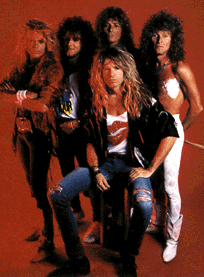 John
Sykes, whose only previous decent song had perhaps been the Phil Lynott
co-write Cold Sweat on Thin Lizzy's Thunder and Lightning
album, joined up with DC in the south of France to begin writing
the next record. In a matter of days the album was written. The search
for a drummer ended when Aynsley Dunbar, who had played
with the likes of
Journey, was persuaded to come out of retirement to join the ranks in 1985. DC finally had
a British drummer after proclaiming that many of the applicants couldn't
drive a lorry, let alone a rock band. Recording could now start....
John
Sykes, whose only previous decent song had perhaps been the Phil Lynott
co-write Cold Sweat on Thin Lizzy's Thunder and Lightning
album, joined up with DC in the south of France to begin writing
the next record. In a matter of days the album was written. The search
for a drummer ended when Aynsley Dunbar, who had played
with the likes of
Journey, was persuaded to come out of retirement to join the ranks in 1985. DC finally had
a British drummer after proclaiming that many of the applicants couldn't
drive a lorry, let alone a rock band. Recording could now start....
Straight away DC and John Sykes had a clash of ideas. First of all Sykes was bemused by the number of old tunes being re-recorded, namely Here I Go Again and Crying In The Rain from the lacklustre Saints and Sinners album. From DC's angle you have to remember that, having finally listened to A & R guru John Kalodner, he was aiming for the US in a big way. As far as that country was concerned Slide It In was the debut album - however bizarre that may sound to european fans, and so it was natural for DC to cover the oldies (particularly Sykes' version of Crying In The Rain which had gone down a storm at the Rock In Rio festival). The two would later butt heads over who would produce the album and there was also the on-going money problems in the background.
In the production chair was Mike Stone. Things were OK to begin with, although Sykes' control over Aynsley Dunbar's drumming had made the latter regard his position in the band as a session (never being given much freedom to express his own ideas). The drum tracks took around three weeks as a result of this but the 'Snakes were getting there. When the bass and rhythm guitar parts were finally laid down it was time to do some vocals. This was where things began to go dramatically wrong....
When DC began singing the basic tracks something wasn't quite right. For a start he sounded rather nasal. Puzzled by this he paid a visit to his Doctor who told him he just had a bad cold. Weeks passed and things still weren't happening. DC began to wonder if he would be able to ever sing again but, rather than be sympathetic, Mike Stone started to get impatient. DC had one last go at singing some guide tracks so that the backing vocals and lead guitars could be added. It was to no avail; he was even struggling to sing in tune this time. Having spent weeks waiting for DC's cold to heal Mike Stone allegedly suggested to him that maybe he should get someone else to sing on the album! That was to be the nail in the coffin as far as Stone's position was concerned although, somewhat bizarrely, Sykes carried on using him whilst recording extra guitar parts. By this time the record company Geffen had also stopped paying wages to Neil Murray and Aynsley Dunbar, paying only DC and Sykes who were still recording. Dunbar immediately went AWOL; viewing the whole thing as a session. Neil Murray sold his bass equipment to make ends meet, perhaps not wanting to repeat the same scenario which led to his exit from the band in 1982.
Having finally received a correct diagnosis
for his problem - which turned out to be a severe sinus infection - DC
drafted in Keith Olsen (who had re-mixed Slide It In for the US)
to produce his vocals. The sinus infection required an operation and a
course of antibiotics. After this DC found he had lost his confidence.
He took singing lessons for the first time in his whole life and finally,
having gained back his confidence, began recording the vocal tracks.

Sykes was failing to get his calls returned during the latter stages of recording. It's fair to say that the problems I've described were probably just the tip of the iceberg. He flew out to confront DC and was, after a heated exchange, fired from the band. By this time Adrian Vandenberg had recorded a solo over Here I Go Again but, when the album was completed, DC didn't actually have a band and was in serious debt to his record label!
The album itself was a pure pop-metal classic. The Coverdale/ Sykes partnership had produced an inspired and soon to be inspirational record. With layer upon layer of guitar and thunderous drums the album was a somewhat different direction for Whitesnake whose brand of blues rock had been injected with a dose of heavy metal. DC sang phenomenally; hitting notes he could only have dreamed about in his Deep Purple days. It was not everyone's cup of tea however. Older fans disliked the screaming vocals and heavier guitar work. Titled simply Whitesnake - later to become known as 1987 to avoid confusion with the early solo album - the new record had seen DC completely re-invent himself musically. The old logo was replaced by a sophisticated Hugh Syme painting (soon to be copied badly by a huge number of hard rock bands).
Neil Murray was no longer in the band; finding out, somewhat embarrassingly, from a journalist at Kerrang! magazine. Also, he and Aynsley Dunbar had to engage lawyers to get their rightful cut in royalties. DC's actions at this time, especially towards Murray were rather ruthless. Whether this was due to the latter leaving Whitesnake back in 1982 (to join Gary Moore) is open to question.
When it came to the promo videos for the album a group had to be assembled. Stylists were brought in and DC suddenly had long, but neatly trimmed, blonde hair! He would later claim that this had been a hairdressing accident. Also gone were the jeans and T-shirt of old; replaced with leather and bangles. With old friends Adrian Vandenberg, Rudy Sarzo, Tommy Aldridge, and the John Kalodner recommended Vivian Campbell, three video promos were shot; Here I Go Again, Is This Love, and the epic Still Of The Night. After the shoot DC thanked them all, saying he'd love to work with them in the future. At this stage he couldn't even offer them wages as he was deep in debt to the record company!
The album was released in europe with a different track listing to its US counterpart. The re-recorded Coverdale/ Marsden track Here I Go Again did not make it on to the original UK pressings as it had already been a minor hit there in 1982. John Sykes' version made it as a b-side to the epic Still Of The Night as the first single in the UK. Yet it was another version of Here I Go Again, a much poppier run through featuring a group of session players (including future 'Snake Denny Carmassi on drums), that catapulted the album into the stratosphere. Here I Go Again USA remix was a massive radio hit. For some strange reason, however, it was John Sykes' harder hitting version that accompanied the promo video and appeared on the album. Further hit singles followed in the form of the classic ballad Is This Love and the bouncing pop-metal of Give Me All Your Love.
On his reasons for having a completely new band DC was quoted as saying he would no longer settle for second best anymore. Thus, when he received a huge advance off US promoters to tour the record he was finally able to pay wages again and offer the players in the videos positions in Whitesnake. The tour was a huge success in the US supporting acts such as Motley Crue. Very soon it was the 'Snakes headlining themselves thanks to the aforementioned hit singles which had received heavy rotation on MTV.
After a successful lengthy tour thoughts began to turn to the next record and very soon came the first casualty. Vivian Campbell was fired from the band. DC had tried, painstakingly, to get him to submit new material. When he finally presented some songs they were more in the line of what U2 were doing. Adrian Vandenberg was later to tell of how Campbell also surrounded himself with people who tended to poke their noses into things that were not their concern.
The 1987 album sold 6,000,000 copies in the US alone; Whitesnake had arrived on the world stage....
This article written by Phillip Hackney